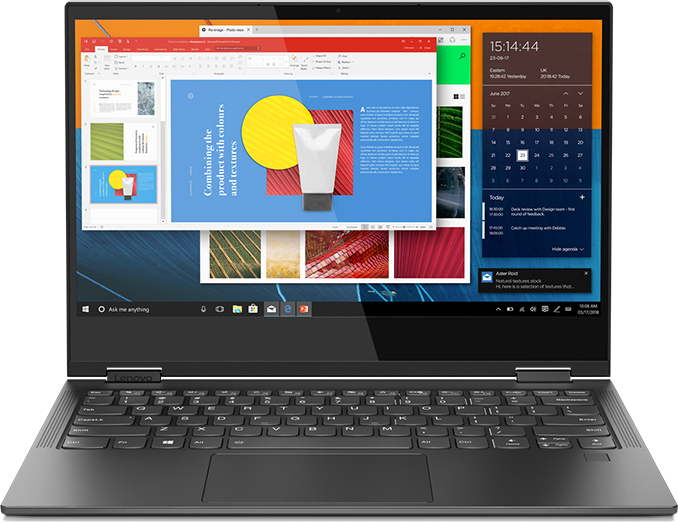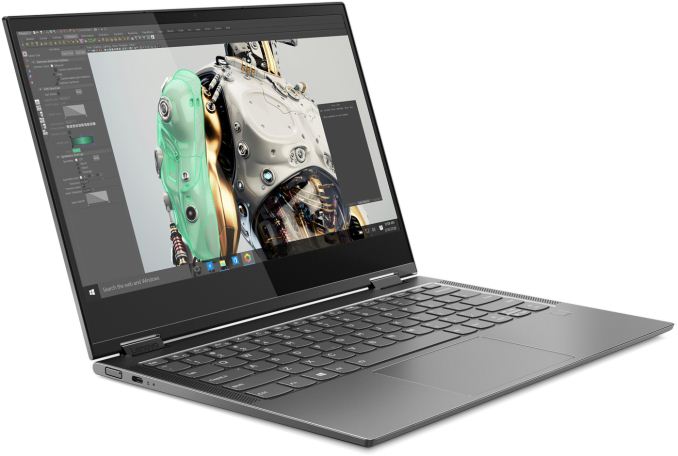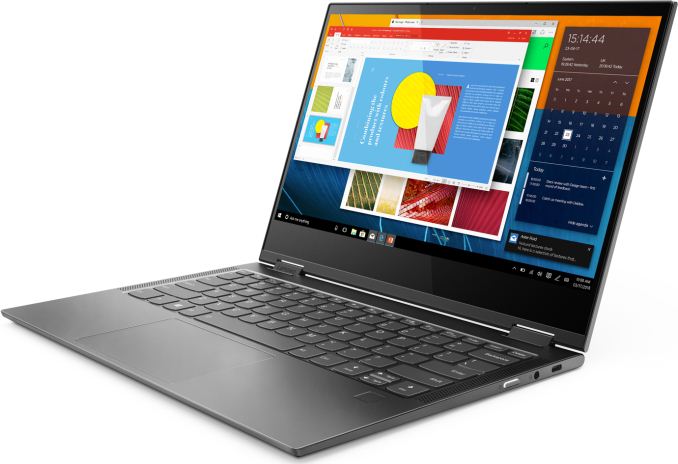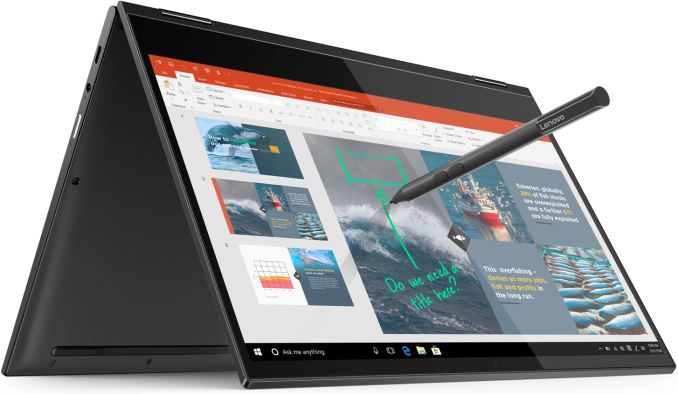Lenovo Announces Yoga C630: The First Windows on Snapdragon 850
by Anton Shilov on August 31, 2018 8:00 AM EST
Lenovo on Thursday introduced the world’s first laptop based on Qualcomm’s Snapdragon 850 SoC. The Yoga C630 promises to deliver a considerably higher performance than the first-generation Windows-on-Snapdragon machines because of SoC improvements as well as optimizations made to the OS. Lenovo says that the Yoga C630 can work for over 25 hours on one charge, thus beating every other convertible PC available today.
Lenovo’s Yoga C630 comes in a convertible laptop form-factor featuring a 13.3-inch Full-HD display with multitouch support. The notebook is made of aluminum, it is just 12.5 mm thick and weighs about 1.2 kilograms, thus being both thinner and lighter than the company’s previous-gen Miix 630 2-in-1 detachable PC powered by the Snapdragon 835. Being based on a mobile SoC, the Yoga C630 does not require any fans and therefore does not produce any noise.
As noted above, the Lenovo Yoga C630 is based on the Qualcomm Snapdragon 850 SoC featuring eight cores and Adreno 630 GPU. The chip is accompanied by 4 or 8 GB LPDDR4X memory as well as 128 GB or 256 GB of solid-state storage featuring a UFC 2.1 interface. As for wireless connectivity, the convertible laptop naturally has an integrated Snapdragon X20 LTE modem that supports up to 1.2 Gbps speeds over appropriate networks as well as a 802.11ac Wi-Fi controller that also supports Bluetooth 5. In addition, the system has two USB Type-C ports, a fingerprint reader, a webcam, stereo speakers, a microphone, and an audio jack for headsets.
Qualcomm itself promises that its Snapdragon 850 offers a 30% higher performance, a 20% longer battery life, and a 20% higher Gigabit LTE speeds when networks permit. That said, it is more than reasonable to expect systems based on the S850 to be faster than notebooks powered by the S835 right out of the box. Meanwhile, there are other important factors that makes Arm-powered Windows 10 systems more attractive in general: Microsoft has re-optimized its Edge browser for the WoS (Windows on Snapdragon) device, whereas Qualcomm has implemented a 64-bit SDK for developers looking to optimize their code for the WoS. Assuming that software makers are interested in the platform, they will release optimized versions of their programs in the coming months or quarters.
With a more compact design, a lower weight, a longer battery life, and a higher performance right out of the box, the Lenovo Yoga C630 looks better than the Miix 630 in every possible aspect. Obviously, software compatibility and performance in applications that run via emulation might still be a question, but Qualcomm and Microsoft are working on issues and all companies involved state that the market these devices are aiming for use UWP programs anyway.
| The Lenovo Yoga C630 | ||
| Specifications | ||
| Display | 13.3" IPS 1920×1080 |
|
| CPU | Qualcomm Snapdragon 850 4 × Kryo 385 Gold - 2.95 GHz, 4 × 256 KB L2 4 × Kryo 385 Silver - 1.80 GHz, 4 × 128 KB L2 |
|
| Graphics | Adreno 630 at 710 MHz (737 GFLOPS) | |
| RAM | 4 GB or 8 GB LPDDR4X | |
| Storage | 128 GB or 256 GB UFS 2.1 | |
| Wi-Fi | 2×2 802.11ac/ad Wi-Fi | |
| Bluetooth | Bluetooth 5 | |
| WWAN | Qualcomm X20 Gigabit LTE | |
| USB | 3.0 | 2 × Type-C |
| Cameras | Front | Webcam with IR and Windows Hello |
| Rear | None | |
| Other I/O | Microphone, stereo speakers, audio jack, trackpad, etc. | |
| Battery | ? Wh | |
| Battery Life | 25 hours | |
| Dimensions | Width | 306.8 mm | 12.08" |
| Height | 216.9 mm | 8.52" | |
| Thickness | 12.5 mm | 0.49" | |
| Weight | 1.2 kilograms | 2.6 lbs | |
Lenovo’s Yoga C630 convertible laptop will hit the market in EMEA region already in September at prices starting from €999. The company will start sales of the hybrid WoS notebook in the U.S. sometimes in November with MSRPs from $849.99, which is actually cheaper than the price of the Miix 630.
Related Reading
- Lenovo’s Miix 630 Snapdragon 835-Based 2-in-1 Now Available
- Qualcomm Announces Snapdragon 850: A Second Generation For Windows
- HP’s Snapdragon 835-Based Envy X2 2-in-1 Available for Pre-Order, Starts at $999
- Lenovo Unveils Miix 630 2-in-1: Windows 10 S, Snapdragon 835, Gigabit LTE, 20 Hrs
- ASUS Announces the NovaGo (TP370): A Snapdragon 835 based Windows 10 PC
- Microsoft Launches Windows 10 On ARM: Always Connected PCs
- Microsoft and Qualcomm Collaborate to Bring Windows 10 & x86 Emulation to Snapdragon Processors














24 Comments
View All Comments
yeeeeman - Friday, August 31, 2018 - link
Not worth more than 500 bucks given the fact that it competes with Pentium processors and it runs only a handful of x86 apps and those at reduced speeds.yhselp - Friday, August 31, 2018 - link
I hope the fact Microsoft hasn't released a Snapdragon Surface device, doesn't mean it considers the chips suboptimal for now, although it might.eastcoast_pete - Friday, August 31, 2018 - link
The surface lines are MS hardware flagships, so they went with tried&true Chipzilla processors to reduce the risk of teething problems, which Surfaces had several of as we know. They might re-evaluate for the next generation, after others have tested the waters. The 1000 series of Snapdragons might be of interest then, and is likely already being tested.yhselp - Saturday, September 1, 2018 - link
It'd be nice if they release a Snapdragon Surface Go; I imagine most people wouldn't use that 10" device as a fully-fledged computer, would never upgrade the Windows 10 S that comes with it, which is pretty much as limited as Windows 10 "Arm". They should be able to sell it for $300 as well, given how the current models retails for $400 and has a $160 Intel chip inside.So a Snapdragon Surface Go that pretty much does everything the current Intel model does, with the same speed, for $100 less sounds pretty good actually.
sing_electric - Thursday, September 6, 2018 - link
I think MS is being twice bitten, thrice shy after Surface RT.dbdavis1990 - Friday, August 31, 2018 - link
You are spot on.digiguy - Friday, August 31, 2018 - link
The truth about battery life is that you don't get more than half of what manufacturers announce if you use high brightness and multitask a lot. I use 75% to 100% brightness depending on the pc and for instance a surface pro 3 doesn't even get 4 hours with me. With an XPS 13 full hd I wouldn't be confident to not bring a charger to give a full day training (7 hours of power point plus browsing during the breaks plus trip on the train in the morning and on the way back in the evening). This might be the only pc I could confidently use all day and not worry about the charger, if performance is good enough (good enough for me is M3 with SSD and at least 8GB RAM).timecop1818 - Friday, August 31, 2018 - link
... and literally nobody gave a shit.i run windows to use quality software, not the shit filling the wasteland that is the Microsoft app store.
baka_toroi - Friday, August 31, 2018 - link
Could you install Linux on such a computer or is it bootloader locked?zodiacfml - Saturday, September 1, 2018 - link
I expected a price of $950 but still too damn expensive. This isn't even a 7nm chip. They should know better that most people aren't into PCs anymore and this is the perfect time to get more aggressive before Intel starts putting out decent stuff in 2020.Built-in LTE is nothing if I can set my phone as a hotspot.
Additionally, can't they make this dual boot to Android? It appears that Qualcomm is motivated by Microsoft.